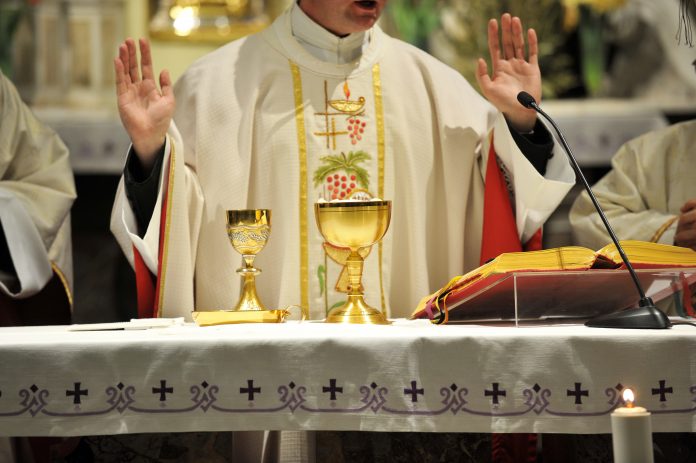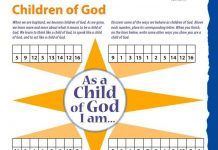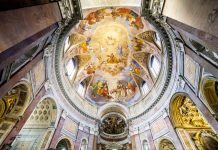
PATRICIA MATHSON
See the end of this article for a list of questions you can use with your learners to review the Mass.
The Mass calls us together as a community. We were created to give praise and glory to the God who loves us without end. We remember all that God has done for us.
The Mass celebrates who God is and who we are as the People of God. Through our participation in the Mass, we learn to have hope in God, hope in the future, and hope in one another. Participating in the Mass reminds us of what is important in life. The Mass gives meaning and direction to our lives as followers of Jesus Christ. Our celebration of the Mass is part of who we are as Catholics.
As catechists of children and families, we take time to explore the Mass. We show our learners how to live what we celebrate at Mass. The following ideas can help you do that. Choose activities to fit one session on the Mass or do part of the Mass at each of several consecutive sessions. Adapt the activities to suit the age and interests of your learners.
Introductory Rites
We gather together as followers of Jesus Christ at Mass. We lift up our voices in song to praise God. We ask forgiveness for the things we have done and not done because we know that God forgives us. We are a community and join our prayers to the prayers of others to give glory and praise to God.
Listen to music
Help learners become familiar with songs sung at Mass. Play a CD with upbeat Mass songs as your learners arrive for the session. Pick one song and discuss the words and what they mean for us as followers of Jesus Christ. Through the God-given gift of music, we give praise to God. Music reaches the human heart in ways nothing else does. Encourage all your learners to sing at Mass as part of the assembly.
Make a mosaic cross
We begin our celebration of the Mass with the Sign of the Cross. This is an important act of faith for us as Catholics. It reaffirms our belief in God who is Father, Son, and Holy Spirit. The Sign of the Cross reminds us of all Jesus has done for us out of love. It is a renewal of our commitment to live as followers of Jesus Christ in all that we do.
Have learners make a colorful mosaic cross to remind them to live as followers of Jesus Christ. Each person cuts out a 5” x 7” cross from green craft foam. Then decorate the crosses with self-stick foam shapes such as triangles, squares, and circles of various sizes and colors.
Talk about giving glory to God
At Mass, we lift up our hearts and our lives to the God who created us and loves us. Mass celebrates who God is and who we are as the People of God. We praise God as a community with the words of the Gloria. We begin this prayer with “Glory to God in the highest.” We echo the words of the angels to the shepherds when Jesus was born (Luke 2:14). We give praise to God for all that God has done for us.
Talk with your learners about giving glory to God by word and action each day. Help them think of ways to do this throughout the week, such as praying to God, reading and learning about the Bible, helping those in need, and living as Jesus taught us.
Liturgy of the Word
We listen to the Word of God proclaimed from Scripture. The First Reading is usually from the Old Testament—except during the Easter Season, when we read from the Acts of the Apostles. The Second Reading is from the New Testament, and then the Gospel is proclaimed. In the homily, we reflect on how we can live the Word of God in our lives. Our response to the Word of God is to say the Creed together.
Create psalm posters
Each time we come together at Mass we pray the beautiful words of the Responsorial Psalm. Generation after generation has used the words of the psalms to lift up their hearts and lives in praise of God. Learners can give glory and praise to God with artwork that illustrates the psalms. Encourage each person to print a verse or two from a psalm at the bottom of a small piece of poster board, and then to decorate the rest of the poster board with images of what the verse or verses mean.
Some psalm verses that are great for illustration are “May the peoples praise you God” (67:6); “Give thanks to the LORD” (105:1); “Great are the works of the LORD” (111:2); “This is the day the LORD has made” (118:24); “I thank you, LORD, with all my heart” (138:1).
Share ways to pray to God
The Second Reading at Mass is proclaimed from the letters of the New Testament. Read one of the Scriptures used for a Second Reading, such as the First Letter to the Thessalonians 5:16-18. This reading calls us to “Pray without ceasing.”
Remind learners that it is important to pray at Mass and throughout the week. Help them think of times and places when they can pray, including in the morning, at night, and before and after meals. Encourage them to take prayer breaks during the day, to pray in times of sadness and in times of joy, and to pray at church, at home, and outdoors. Wherever we are, God is—and there can be prayer.
Roleplay the Gospel
The Gospels teach us about Jesus and what he did and said. At each Mass we hear a reading proclaimed from one of the Gospels: Matthew, Mark, Luke, or John. We remember what Jesus taught and all that he has done for us. The homily helps us live the Word of God in our lives.
One Gospel story that we hear at Mass is about Jesus and the children. Role-play this Gospel as it appears in Mark 10:13-16. Ask for volunteers to play the parts of children, adults, disciples, and Jesus. Encourage those participating to improvise actions and facial expressions, with and without words. Learners can act out the children being brought to Jesus, the disciples telling the adults and the children to go away, and Jesus welcoming the children. This story helps us remember that Jesus loves each of us.
Explore the Creed
We respond to God’s Word in Scripture and the homily by stating our faith in God. Explore how the Creed is divided into three parts. The first section is about God as Father and Creator. Read Genesis 1:1-3 with your learners; see how God created the heavens and earth. Ask learners to name some of the things that God has made especially for them.
The next part of the Creed is about Jesus Christ. Read Matthew 16:15-16, where Peter proclaims his belief that Jesus is the Son of God. Tell learners to think of things Jesus has done for them, such as showing us God’s love and bringing us new life.
We then proclaim our belief in the Holy Spirit. Read Romans 5:5, about how the gift of the Holy Spirit is given to each of us. Ask learners to name ways in which the Holy Spirit helps us, such as guiding us toward making the right choices and filling our hearts with love and mercy for others.
Pray with hearts
Through the Prayers of the Faithful at Mass, we pray as a community for the needs of others. Together we respond, “Lord, hear our prayer.” Discuss with learners the importance of praying for other people, such as those who are sick, hungry, or in any kind of need in our communities and around the world.
Encourage learners to continue to pray for the needs of others throughout the week. Give learners red paper hearts and ask them to write on them the names of those for whom they will pray during the coming week.
Liturgy of the Eucharist
We thank God for all that God has done for us; we thank God for life itself. We give over to God all that we are and all that we do. We remember that we depend on God for all things. Together we offer to the Father the gift of Jesus Christ through the action of the Holy Spirit. This is the greatest gift we can offer.
Write a thank-you letter to God
Explain to your learners that the word Eucharist means “thanksgiving.” In the Eucharistic Prayer, we offer thanks to God. Encourage learners to think of things for which we should give thanks, such as creation, people, and God’s love. Invite learners to write thank-you letters to God. Encourage them to give thanks to God each day.
Ask questions about the Our Father
Jesus taught us the Our Father (Matthew 6:9-13; Luke 11:2-4), which is also called the Lord’s Prayer. When we pray the Our Father, we are saying that we are one with all people. Discuss this prayer and ask questions of the learners such as: What does it mean to call God our Father? How can we honor God’s name? Why is it important to forgive others? Explore the idea that we are not just to say the words of the Our Father, but to live every day what the words mean.
Draw a picture of living in peace
At the Sign of Peace, we say to one another “Peace be with you.” These are the words that Jesus said to his Apostles in the Upper Room after his Resurrection (John 20:19). He forgave the Apostles who had run away and denied him. He offered them his peace.
Talk with learners about ways to be peacemakers. Include ideas such as asking forgiveness of those we have hurt, letting go of grudges, and standing up for the rights of others. We must take responsibility for our actions and not make excuses. Ask learners to draw pictures showing one way they can live in peace with others. This personalizes the idea of how we live out these words.
Look up the Last Supper
Read aloud the account of the Last Supper in Luke 22:14-20. Emphasize that the Eucharist is a gift that is freely given to us by God out of love. The Eucharist is the gift of the Real Presence of Jesus Christ himself. Explain that the response, “Amen,” is a declaration of our belief.
Concluding Rites
We leave Mass to go out and live Spirit-filled lives. We have been renewed by the Word and the Eucharist. We go to share the Good News of Jesus Christ and to serve others in his name. We know that we are called to live what we have celebrated. We are to share the gospel of Jesus Christ with others.
Be a blessing to someone
At the end of Mass, the priest asks God’s blessing on us in the name of the Father, the Son, and the Holy Spirit. We make the Sign of the Cross and say “Amen.” We are reminded that God is with us in all that we do. We go out to share the Good News with others and to live as followers of Jesus Christ.
Explain to your learners that we can be a blessing in the lives of other people. Help them think of ways they can do this, such as visiting someone who is lonely, reading to a young child, helping a person in need, or inviting someone to Mass. Ask each learner to write down “I will be a blessing to someone this week by” and add what he or she will do. Each of us can make a difference—for, with God, all things are possible.
How to Encourage Families to Participate in Sunday Mass
Invite the children to join the children’s choir, train as altar servers, or be involved in other ministries. Be sure that families get details about these opportunities for their children and are encouraged to be a part of every celebration.
Connect youth with teen activities in the parish. Let them and their families know about teen liturgies, service days, and youth group events. Connect them to one another.
Explore Sunday readings with a weekly reflection question. Discuss the question with the children and invite families to do this at home. This helps families relate Scripture to their everyday lives.
Involve children and families in parish service projects. Explain the project, give families the details they need, and encourage their participation.
Promote use of the parish website. This makes parish information available 24 hours a day. Make bookmarks with the website address to give out.
Welcome families with children who have not yet prepared to received the Sacraments. Be understanding and available, and support them on their faith journey.
Explain children’s Liturgy of the Word if your parish offers it. Be sure that families understand that their children are welcome to be a part of this activity at Sunday Mass.
Share information about the parish patron saint and celebration of the feast day. This helps families know what is going on in the parish. Hand out holy cards of the parish patron saint.
Encourage families to pray together at Sunday Mass and at home. Give them ideas and resources that are easy to use. Provide prayers and activities for each liturgical season.
Questions for Review
The following questions can help learners review the Mass. Select only a few questions for younger children and more for older learners. Also encourage learners to ask their own questions. Write the four parts of the Mass on pieces of poster board, one on each piece. Display each “part” as that part of the Mass is being discussed. This helps students focus on each part of the Mass and reinforces learning.
Introductory Rites
Q: What is the first part of the Mass called?
A: Introductory Rites
Q: Why do we make the Sign of the Cross at the beginning of Mass?
A: Because we are followers of Jesus Christ
Q: What is the name of the prayer that begins with “Glory to God in the highest?”
A: Gloria
Q: Where did we get the beginning words of this prayer?
A: Words of the angels to the shepherds at the birth of Jesus (see Luke 2:14)
Liturgy of the Word
Q: During what part of the Mass do we hear readings from Scripture?
A: Liturgy of the Word
Q: From where is the First Reading taken?
A: From the Old Testament—except during the Easter Season, when we read from the Acts of the Apostles
Q: Why do we sing a psalm at each Mass?
A: To give praise and glory to God
Q: From where is the Second Reading taken?
A: From the New Testament
Q: Name the Four Gospels.
A: Matthew, Mark, Luke, and John
Q: Why do we have a homily?
A: To help us live the Word of God
Q: Who do we say we believe in with the words of the Creed?
A: God the Father, Son, and Holy Spirit
Q: What is it called when we pray for the needs of others?
A: Prayers of the Faithful
Liturgy of the Eucharist
Q: What part of the Mass comes after the Liturgy of the Word?
A: Liturgy of the Eucharist
Q: What does the word eucharist mean?
A: Thanksgiving
Q: For what do we thank God?
A: For sunshine, flowers, music, life, people, love, everything
Q: What prayer did Jesus teach his disciples?
A: Our Father (the Lord’s Prayer)
Q: What can we say to one another at the Sign of Peace?
A: Peace be with you
Q: Where do the words of the Sign of Peace come from?
A: Greeting of Jesus to his disciples after the Resurrection (see John 20:19)
Q: Who is present in the bread and wine of the Eucharist?
A: Jesus Christ
Q: When did Jesus give us the Eucharist?
A: At the Last Supper
Concluding Rites
Q: Who does the priest ask to bless us?
A: God—Father, Son, and Holy Spirit.
Q: What do we do at the time of the blessing?
A: Make the Sign of the Cross
Q: What do we do after Mass?
A: Share the Good News of Jesus Christ with others
Patricia Mathson has many years of experience in faith formation as a DRE and holds a Master of Religious Education degree. She is currently the children’s ministry coordinator at Hope Family Center in Des Moines, IA. She is the author of ten books with the latest titled 70 Sacrament Starters for Children (Twenty-Third Publications).
This article was originally published in Catechist magazine, December 2009.
Image Credit: Shutterstock 462646417




